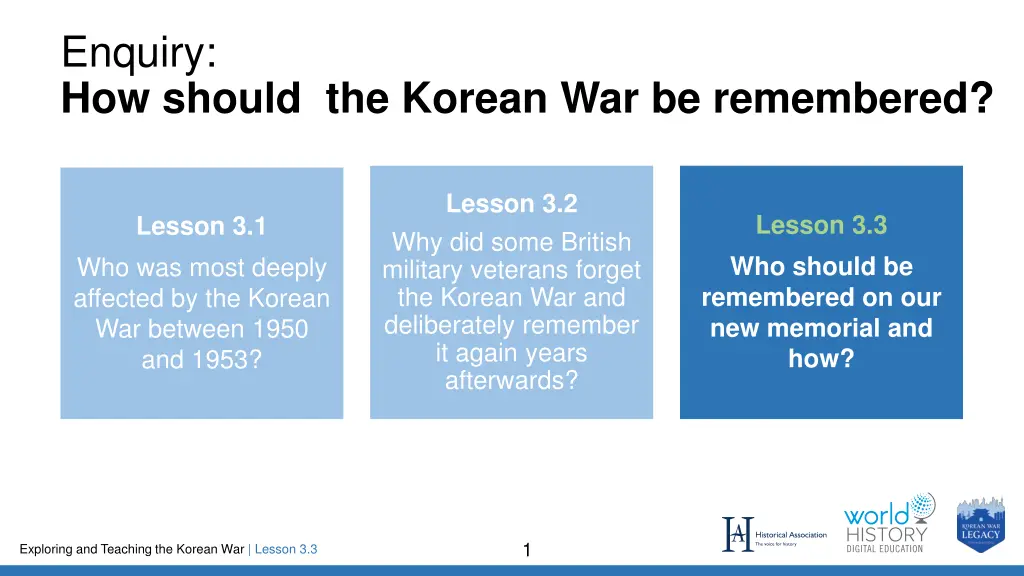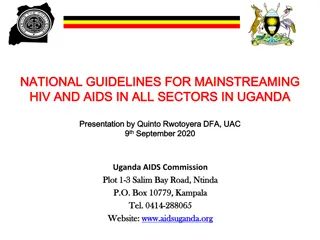
Honoring the Legacy of the Korean War: A Memorial Design Exploration
Explore the significance of the Korean War and how it should be remembered through the creation of a new memorial. Analyze existing memorials, design a new one, and consider the inclusion of different elements to commemorate this pivotal moment in history.
Download Presentation

Please find below an Image/Link to download the presentation.
The content on the website is provided AS IS for your information and personal use only. It may not be sold, licensed, or shared on other websites without obtaining consent from the author. If you encounter any issues during the download, it is possible that the publisher has removed the file from their server.
You are allowed to download the files provided on this website for personal or commercial use, subject to the condition that they are used lawfully. All files are the property of their respective owners.
The content on the website is provided AS IS for your information and personal use only. It may not be sold, licensed, or shared on other websites without obtaining consent from the author.
E N D
Presentation Transcript
Enquiry: How should the Korean War be remembered? Lesson 3.2 Why did some British military veterans forget the Korean War and deliberately remember it again years afterwards? Lesson 3.3 Who should be remembered on our new memorial and how? Lesson 3.1 Who was most deeply affected by the Korean War between 1950 and 1953? 1 Exploring and Teaching the Korean War | Lesson 3.3
Lesson 3.3 Overview Content covered in this lesson Compare Korean War memorials from around the world Decide who should be commemorated on your memorial Design your new memorial and write an explanation of your design Lesson 3.3 Who should be remembered on our new memorial and how? 2 Exploring and Teaching the Korean War | Lesson 3.3
Korean Veterans Memorial, National Memorial Arboretum, Staffordshire, UK Starter Study the information about this memorial on the next slide. Do you think this is a good memorial? Why? Does this memorial do justice to the people and issues that we have been examining? Why? 3 Exploring and Teaching the Korean War | Lesson 3.3
Information about the memorial The memorial includes four boulders, each representing one of the four years in which the British Armed Forces participated in the Korean War from 1950 to 1953. Each boulder has a metal plaque on it, explaining what happened in each year. There are three flags flying, those of Britain, South Korea and the United Nations. Surrounding the memorial are 25 trees that typically grow in Korea. The memorial was opened in 2000 by the Korean Veterans Association on the fiftieth anniversary of the outbreak of the Korean War in 1950. 4 Exploring and Teaching the Korean War | Lesson 3.3
Design a new Korean War memorial Your commission Suppose that the existing Korean Veterans Memorial is to be replaced but on the same site. Your task is to design a new memorial that will be ready for opening in 2023 on the seventieth anniversary of the end of the Korean War. You should be able to justify: Who you have included or excluded from the memorial and why. What materials, symbols, images and words you have included and why. You can make more than one design if you wish to cover different options. 5 Exploring and Teaching the Korean War | Lesson 3.3
Learn from other Korean War memorials Symbols: What flags or symbols are visible? Why have they been included? Words: What words can you see? Why have they been chosen? Location: Where is the memorial? What kind of environment surrounds it? Activity 1 Study the war memorials on Slides 7 16. Use these questions to guide you. Which memorial most appeals to you and why? Audience: Who is meant to see it? Might someone be offended by it? If so, who and why? Impact: What overall impression does it give you? People: What human figures are shown? What are they doing? Who are they? Materials: What is the memorial made from (e.g. wood, stone, metal)? Funding: Who paid for it and why? Date: When was it made? Note: You may not be able to answer all these questions about every memorial. 6 Exploring and Teaching the Korean War | Lesson 3.3
Part of a Chinese communist memorial to the Korean War 7 Exploring and Teaching the Korean War | Lesson 3.3
Information: Chinese communist memorial to the Korean War The memorial shows General Peng Dehuai leading Chinese soldiers across the Yalu River from the border city of Dandong in October 1950. The soldiers were sent to help North Korea fight UN forces, who were close to the Chinese border and might threaten communist China itself. Chinese troops helped to push back the UN troops. The soldiers were officially known as volunteers , which avoided the Chinese government having to declare war against UN forces. For Peace is written in English and Chinese at the foot of the statue. Chinese support for North Korea was meant to end the war and so bring peace to the whole of Korea. The Chinese saved North Korea from defeat. In China, the Korean War is known as the War to resist US aggression and aid Korea . The memorial forms part of a museum about Chinese involvement in the Korean War. The museum was built in Dandong in the 1990s. 8 Exploring and Teaching the Korean War | Lesson 3.3
The Statue of Brothers in Seoul 9 Exploring and Teaching the Korean War | Lesson 3.3
Information: The Statue of Brothers war memorial in Seoul The statue shows two Korean soldiers from the Korean War embracing across a split concrete dome. The taller, well-armed soldier with a helmet represents a South Korean soldier reunited on a battlefield with his younger, unarmed smaller brother from the North Korean Army. The split concrete dome represents a Korea still divided between two states. The inside of the dome includes a floor map showing 16 allies from United Nations forces who assisted South Korea in its war with North Korea and communist China. The memorial is intended to show the past sufferings of the Korean people and their determination to achieve national harmony, unity and prosperity. The memorial was opened in 1994, after South Korea became a democracy in 1987. 10 Exploring and Teaching the Korean War | Lesson 3.3
US Korean War Veterans Memorial, Washington DC 11 Exploring and Teaching the Korean War | Lesson 3.3
Information: US Korean War Veterans Memorial, Washington DC This memorial shows 19 larger-than-life stainless steel statues of members of the US Armed Forces in combat gear, warily crossing a field during the Korean War. The ground is planted with low-lying juniper bushes to look like a Korean rice paddy field. The statues deliberately include all the different ethnic groups who served in the American Army, e.g. African-Americans, Native Americans, etc. There are no statues of other nationalities or of South Korean civilians (although the countries who took part as US allies are listed on another part of the memorial). The memorial was opened in 1995 by the US and South Korean presidents. In 2015, Samsung, a South Korean company, paid money for the maintenance of the monument. 12 Exploring and Teaching the Korean War | Lesson 3.3
Korean War memorial in the port of Cartagena, Colombia, South America 13 Exploring and Teaching the Korean War | Lesson 3.3
Information: Korean War Memorial in the port of Cartagena, Colombia, South America The metal sculpture shows a sixteenth-century Korean ship called a Geobuksean (a turtle ship). This was used to defend the country against a Japanese invasion. The ship stands on a stone platform, which includes a plaque and sculptures of cannons. Two flagpoles come out of the ship flying the Colombian and South Korean flags. The memorial is located in Cartagena because Colombian troops who were sent to support United Nations forces started their sea journey to Korea from Cartagena. Colombia was the only South American country to take part in the Korean War. The memorial links how Korea resisted Japanese aggression in the sixteenth century with how Colombia helped South Korea to resist North Korean aggression in the twentieth century. The memorial was paid for by the South Korean government and built in 2016. 14 Exploring and Teaching the Korean War | Lesson 3.3
Memorial at the Victorious Fatherland Liberation War Museum, Pyongyang, North Korea 15 Exploring and Teaching the Korean War | Lesson 3.3
Information: Memorial at the Victorious Fatherland Liberation War Museum, Pyongyang, North Korea This group of larger-than-life statues shows North Korean soldiers charging fiercely behind a North Korean flag. In North Korean propaganda, the Korean War is referred to as a war of liberation to free South Korea from its puppet government and US occupation. It is described as a victorious war, thanks to the brilliant leadership of Kim Il- sung, North Korea s first communist dictator. At different times since the war, North Korea has sometimes mentioned Chinese military support, which helped it to survive, and sometimes claimed victory just for itself. The museum was built on its present site in 1963. 16 Exploring and Teaching the Korean War | Lesson 3.3
Who should be remembered? Activity 2 Look at this list of possible people to include. Decide who is going to be commemorated on your memorial and why. Support your choice with reference to all that you have studied in previous lessons. A memorial to All British soldiers who died? All British soldiers who served? All United Nations soldiers who died? All United Nations soldiers who served? All soldiers from all sides who died (including those from North Korea and China)? All Korean civilians who died? 17 Exploring and Teaching the Korean War | Lesson 3.3
How should they be remembered? Your commission a reminder Your new memorial will be on the existing site of the Korean Veterans Memorial at the National Arboretum. Your new memorial would be opened in 2023 on the seventieth anniversary of the end of the Korean War. Your design can be a description or a drawing, or a 3-D model if you have time. Write or record an explanation of your design. Make sure that you include: a) Who you have included or excluded from the memorial and why. b) What materials, symbols, images and words you have included and why. c) Your audience: who do you want to see it? You can make more than one design if you wish to cover different options. 18 Exploring and Teaching the Korean War | Lesson 3.3
Focus on In your design, focus on these aspects: People: Should it show people and, if so, what kind of people and how should they be represented? Realistic, like statues, symbolic or abstract? Symbols: Such as flags or icons? Materials: What will it be made of so that it lasts/matures over time? Words: Quotes from veterans, inspirational texts, religious texts, names of the dead, statistics, information about the war? 19 Exploring and Teaching the Korean War | Lesson 3.3
Heres one I made earlier! In this video, Felix from Cottenham Village College explains the design that he came up with for his new Korean War memorial. 20 Exploring and Teaching the Korean War | Lesson 3.3
Plenary What might Bill Speakman VC think of your new memorial designs? 21 Exploring and Teaching the Korean War | Lesson 3.3






